

The subject of ‘health’ must be transferred to the Concurrent List of the Indian Constitution from the State List, the high level group (HLG) formed for the health sector by the 15th Finance Commission has said.
Since issues like medical education and family planning fall under the concurrent list, health also should, the panel said in a report submitted recently to the Finance Commission.
“This is very strange,” T Sundararaman, former executive director of National Health Systems Resource Centre, said.
“Some of the states have been doing really well with or without the Centre’s support. Some have refused to accept central schemes in toto or otherwise according to their requirement. While we have been pitching for decentralisation of power and fund allocation, this is exactly a step in opposite direction,” he added.
The HLG is chaired by All India Institute of Medical Sciences Director Randeep Guleria and consists of Devi Shetty (Narayana Health City), Deelip Govind Mhaisekar (Maharashtra University of Health Sciences), Naresh Trehan (Medanta Medicity), Bhabatosh Biswas (R G Kar Medical College) and K Srinath Reddy (Public Health Foundation of India).
The HLG has also stamped the Public Private Partnership (PPP) model of the Niti Aayog. Incentivise the private sector to open 3,000-5,000 small hospitals in India’s Tier II and III cities in order to overcome the paucity of hospitals in the country, it has recommended to the Commission.
“We find there is a conflict of interest in the panel as two of the members are directly linked with the private sector. While we strongly oppose the very proposition, we are not surprised at this recommendation because of the composition of the panel,” Sundararaman told Down To Earth.
Private medical colleges should be linked with government district hospitals, the Niti Aayog had recommended a few days back.
Incidentally, in a recently released book, Make Health in India, Reddy described the PPP model as a ‘partnership for profit’ model.
“The models of PPP deployed so far have not worked well for several reasons. Poorly designed contracts, vaguely defined deliverables and inadequately enforced accountability have frequently led to failures in service delivery, especially to the poor,” he had said.
India will not be able to spend 2.5 per cent of its Gross Domestic Product (GDP) on health by 2025 if the Centre did not increase its allocation according to the timeline it proposed, the panel said. Also, states needed to spend at least eight per cent of their respective GDPs on health, instead of the current 4.7 per cent.
“The expenditure made by the central government has remained same over the past few years, which is low,” the report stated, adding states had be nudged with specific recommendations by the Commission.
Currently, the share of state and central governments is in the ratio of 63:35. The states should shell out more even in flagship programmes like Ayushman Bharat, it recommended.
Additional allocation of resources to the state governments by the Finance Commission should be done on the basis of a performance-based framework, the report recommended. The framework would consist of four indicators — total state budget (40 per cent), health system performance (30 per cent), public health system cadre (20 per cent) and stunting decline rate (10 per cent).
For medical colleges
The report set an ambitious target of increasing post graduate (PG) medical seats and making them equivalent to MBBS seats by 2025. Currently, there are only 45,000 PG seats against 70,012 under graduate (UG) seats.
It listed a slew of measures, including relaxation of norms for setting up medical colleges to increase the intake of students in medicine at PG and UG level and thus overcome the shortage of human resources in health.
PG students studying in private medical colleges are made to shell out exorbitant fee, which was ‘irrational and against human values’ and must be regulated by ‘authorities’, the report said. On the other hand, the government had made it clear during the debate on National Medical Commission Bill that it won’t fix any upper cap for half of the total seats in any medical college.
The asymmetric distribution of medical colleges needed to be corrected as most medical colleges were situated in western and southern India, it said.
The report supported the notion that the existing structure of evaluating medical colleges on the basis of their infrastructure and human resources needed to be done away with. These parameters used to determine if a medical college would be allowed to admit students and on how many seats.
“It is suggested that there should be a common exit exam for UG medical students qualifying from public and private colleges. Performance of these students in the exit exam will determine affiliation and number of seats for colleges in the coming years,” it said.